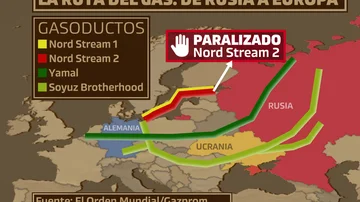The Russian invasion of Ukraine has set off all the alarms about gas supply in Europewell a third of this energy in Europe is provided by the invading country. Its leader, Vladimir Putin, is aware of this and has already threatened to turn off the Europeans. The experts they believe that Putin’s are empty words, because the economy of his country is already being affected by the sanctions to eliminate one of its sources of income: natural gas. On the other hand, in the event that Putin cuts the gas supply to Europe, Europe would react with more sanctions, thus worsening the country’s economy. How does this energy source from Russia get to Europe?
Through three gas pipelines. A gas pipeline is made up of large pipes that serve to transport gas on a large scale. Europe has three main routes for the entry of Russian gas: the Ukrainian, Belarusian and Baltic corridors.
1. The ukrainian runner (light green) is composed of the Soyuz Brotherhood pipeline. It is a channel that part of Russia, passes through Ukraine and reaches Europe. It supplies gas mainly to Eastern European countries, such as Germany.
2. The Belarusian racer (dark green) has the Yamal Peninsula gas pipeline. It runs 4,196 kilometers, from Siberia to Russia. It is one of those more reserves it has and that is why it is very important for Europe.
3. The baltic runner they form the Nord Stream 1 pipeline in Germany (yellow) and in red the Nord Stream 2 (red). The latter is a paralyzed expansion that would allow gas to be sent directly from Russia to Germany through the Baltic. That is, bridging the conflictive area of Ukraine. However, Berlin noted on February 22nd that it will not certify the Nord Stream 2 gas pipelinebeing controlled by the Russian energy giant Gazprom.

Why is Europe so dependent on Russian gas?
The truth is that Russia supplies 45% of the gas What does the European Union matter? Inside of EU there are more and less dependent countries of the energy exports of the invading country. In this sense, 100% of the gas in Finland or Sweden is of Russian origin, in the case of Germany, 60%. In countries like Poland, the Czech Republic, Slovakia or Austria it accounts for more than half of the supply.
However, in Spain we have a very low Russian energy dependency of 9.8%as collected Eph. France a little more, 20%.
What alternatives does Europe have to Russian gas?
Faced with Putin’s threat, the European Commission has had to draw up emergency plans against a possible interruption of Russian gas to Europe. If so, the situation will be complicated because European reserves are 10% below the average of the last decade. For this reason, the EU looks towards United States, Qatar, Azerbaijan and Norwaya, with which Europe is connected by gas pipeline to see how to get an additional proportion of gas. The European institution has already contacted these countries, according to Efe.
In the midst of this situation, Spain could play a primary role and could become “a strategic element to save this energy dependency suffered, above all, by the countries of Central Europe”. This is reflected in the statements of José Manuel Corrales, professor of Economics and Business at the European University, in El Mundo. Until now, Europe has two objectives fixed: expand its gas reserves before the arrival of winter and that Europe is independent of Russia from fossil fuels before 2030.
How does gas get to Spain?
Spain has six international interconnections to guarantee the supply of natural gas through gas pipelines. Algeria is the main supplier of the Spanish Gas System: it represents the 29% of supplies in 2020, according to the Enagás report, manager of the Spanish gas system. This is followed United States, with 16%, who arrive in our country through tanker ships. Nigeria, with 12%, is in third place, as can be seen in the following graph.

Algerian gas reaches Spain through the Medgaz gas pipeline, which flows into Almería. This brings the gas directly from Algeria through a 200-kilometre tube with a maximum depth of 2,160 meters that crosses the Mediterranean. It also did so through the Maghreb-Europe gas pipeline, whose supply was closed by the crisis in Morocco. Despite this, the country promised to send the gas through methane tankers. In this way it is intended to cover its niche: about 6,000 million cubic meters per year. Thus, the first gas pipeline will be expanded to take on 2,000 million cubic meters more. And the rest, 4,000 million, will arrive by sea.
On the other hand, Spain receives liquefied natural gas that arrives from countries such as Nigeria or Norway. It is supplied from 13 different origins, lto most of the United States, Nigeria, Russia and Qatar. As can be seen on the map, it has two terminals, Cartagena and Mugardos. There are also underground storage facilities: Serrablo in Huesca, Gaviota on the coast of Bizkaia and Yela in Guadalajara.

Source: Lasexta
Mario Twitchell is an accomplished author and journalist, known for his insightful and thought-provoking writing on a wide range of topics including general and opinion. He currently works as a writer at 247 news agency, where he has established himself as a respected voice in the industry.











